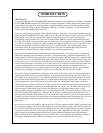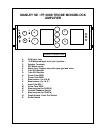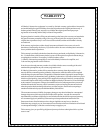
OPERATIONAL NOTES
SWITCHING SINGLE-ENDED 18 / PUSH-PULL 36 This amplifier has the unique feature of
being able to choose between two circuit topologies. You are able to switch between each mode
while the amplifier is turned on and playing music. In SINGLE-ENDED mode the amplifier uses
both 300Bs in parallel. The advantage is a minimalist circuit requiring no "phase splitter",The
disadvantage is a less efficient circuit that produces half the power of PUSH-PULL. In PUSH-
PULL mode each tube works in opposite phase to the other and relies on the output transformer to
make the polarities work together. This has advantages in efficiency and in the distortion and noise
cancellation properties of a balanced circuit. Both ways are operated in "Class A" bias throughout
and both are PURE TRIODE and both modes have a similar short signal path.
SWITCHING VARIABLE FEEDBACK The variable feedback can be changed in 1 dB steps
from zero to 10 dB. The most obvious effect of changing the amount of negative feedback is the
gain change. The more feedback - the less gain but also less distortion and a flatter frequency
response. You should be able to hear that with less feedback, the tonality is more aggresive but the
imaging may have greater detail. As you increase feedback, the amp gets smoother and softer and
slightly brighter. Towards the maximum amount of feedback, the amp may begin to sound like a
good solid state amp. Virtually all solid state amps need large amounts of feedback in order to
sound acceptable. Maximum feedback also corresponds to maximum damping factor. This control
not only affects the tonality of the amp but also of the speaker. The optimum setting depends on the
speaker, the room, and your tastes. Experimentation will be necessary but also fun and educational.
ADJUSTING BIAS This does more for tube life than it does for sound quality. You will need a
DC voltmeter and a small flat screwdriver. This should be checked every few months but does not
need to be necessarily checked and adjusted unless the 300Bs are replaced.
1) Let the amp warm up in SINGLE-ENDED mode for about an hour, then with no music
playing.... Set the volt meter to a low DC range.
2) Put negative or black probe of the voltmeter to a chassis screw (ground) and the red or positive
probe in the small black socket near the FEEDBACK switch below the tube to be adjusted.
3) It should read 740 mV or .74 volts DC. If not -then you can adjust the trimmer without opening
the chassis. It is located in the hole in front of the 300Band is blue.
4) Now adjust the other 300B bias. Use the other black probe socket and the right side trimmer and
adjust the same way. A little "drift" is normal .
5) Switch to PUSH / PULL - you should measure each tube again. The meter should now read
640 mV but more important should measure the same as the other tube. If not adjust one tube to
match the one closest to .64 volts. This cancels hum in PUSH-PULL mode. If a 300B will not
trim as described - then replace it and adjust the bias.
TUBE LIFE
You should expect many years of life from the tubes in your MANLEY SE / PP if you adhere to
the procedures described above and check your bias at least once every 2-3 months. We stock all
the tubes in these amplifiers should you ever need replacements (and at very reasonable prices too!)
FUSES
The fuses used in your amplifier are standard 1/4" x 1 1/4" SLO-BLO types. The correctly rated
fuse has been installed at the factory for your country's voltage. If replacing a fuse, always unplug
the amplifier's power cord from the wall outlet and always use the exact same type and ampere
rating fuse as the one you are replacing. Failure to do so will void your warranty and can be a
dangerous fire hazard. For 240 volts the correct fuses are MDL1 for the mains.













